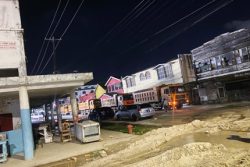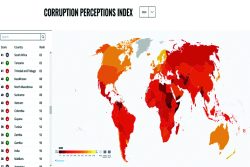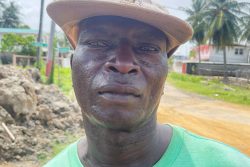Part 5
By Janette Bulkan
In this fifth article in this series, I will discuss the commitments made by VHPI to in-Guyana timber processing, its actual exports of unprocessed logs, the ineffective GFC log export commission, and the failures of the GFC and its Minister to act as public servants.
VHPI commitment to
in-Guyana timber processing
In the same Ministry statement of 13 April 2011, section 13, the Ministry of Agriculture asserted that ‘the company will engage in added value activities . . . Vaitarna has committed to downstream processing and they will be monitored against same’, but gave no details and no timescale. The Government of Guyana has apparently learned nothing from the similarly vague assurances about inward investment given by Barama, Ja Ling, Bai Shan Lin and other Asian loggers of Guyana’s forests. While DFCPL promised to invest US$ 18.7 million in the Rewa concession SFEP 03/07 during 2010-2015, VHPI has indicated no amount for the TSA 01/10. The Times of India reported on 07 April 2011 the intention of taking logs from Guyana through the port of Mangalore to a furniture factory in Chikmagalur. According to Forbes Magazine on 29 June 2011, that factory of 56,000 m2 (600,000 square feet) had not yet been built. The intention of the owner of Café Coffee Day was ‘to build India’s largest retail furniture business’ and his dream was ‘to create an IKEA from India’. So what was the final destination of those 50 containers of logs from TSA 01/10?
VHPI’s actual log exports
VHPI has begun to ship out as unprocessed logs the timbers in the Special Category royalty class, that is, the premium quality timbers of Guyana. The Minister for Agriculture assured that VHPI ‘will first have to present GFC with a full business plan’ (Kaieteur News, 13 April 2011 – ‘Govt. insists nothing secret about concessions’). Was this full business plan actually presented and what did it say about processing in Guyana, employment and training of Guyanese? A year later, VHPI could only say ‘we are currently exploring the feasibility of setting up a wood processing plant at various locations’ (Kaieteur News, 06 April 2012 – ‘Logs shipment…Indian coffee company insists it did nothing wrong – says still in transition phase’). Was that in the business plan approved by the GFC?
Kaieteur News also reported that ‘The majority of logs shipped out are said to be washiba . . . also shipped were purpleheart, greenheart and snakewood’ (Kaieteur News, 05 April 2012 – ‘Indian coffee company ships out 50 containers of logs in 2 months’). According to the GFC’s official species list, snakewood is a royalty class III species, also known as tureli, botanically Zygia racemosa in the family Mimosaceae, synonym Pithecellobium racemosum. Why would a furniture company be shipping logs of snakewood? Presumably VHPI is actually shipping the rare timber letterwood, in the higher-value Special Category royalty class, botanically Brosimum guianense in the family Moraceae, which is sometimes also called snakewood but not in the GFC species list. As the GFC has been penalizing small-scale producers for not using the GFC-approved names, presumably VHPI has also been penalized for this error which could also impact royalty payments?
The GFC noted in its return to the then fortnightly Tropical Timber Market report of the International Tropical Timber Organization 16 (23) 1-15 December 2011 that ‘Guyana washiba in the form of dressed sawnwood attracted a remarkable price average of USD 2,500 per cubic metre’. But the GFC is happy for VHPI to export logs at one-tenth of that price (declared FOB), contrary to the national and PPP policies for processing in Guyana. Washiba (Tabebuia species) is a rare tree in Guyana, about one tree per 133 ha according to inventories in seven logging concessions in 2006 (GFC background paper ‘Proposal for the ban of exports of selected species in log form’, table 2, January 2007). In early 2007, the GFC was proposing a total ban on the export of logs of purpleheart, letterwod and washiba, as well as 12 other timbers, but now it is happy to see them continue to go out from VHPI as unprocessed logs.
The variable rate export commission on logs – fiscally ineffective but profitable for GFC
It is an interesting question as to why the GFC has switched from a desire to ban log exports of most of the valuable timbers of Guyana in January 2007 to support for such export by mid-2008. The national consultation in February 2007 involved some 350 stakeholders and was almost unanimous in support of such a ban on log exports. In terms of conservation of standing stocks of these timbers, employment, upskilling of the labour force, addition of value (and the associated tax revenue from enterprises adding value), export of unprocessed logs is clearly contrary to national policies as approved by the National Assembly. The GFC provided a well-researched post-consultation paper in March 2007, based on a demand study, as to why some timbers should be entirely retained for domestic use in Guyana while others appeared to be in surplus to domestic consumption.
However, by mid-2008, the GFC had changed to favour an increase in the export commission on logs. From January 2009, 26 species have had their log export commission rates raised from 2 per cent to 7 per cent in 2009, 10 per cent in 2010 and 10 or 12 per cent in 2011. Those increases had no effect on the major exporter Barama, whose secret Foreign Direct Investment agreement requires only a 2 per cent payment on greenheart logs and which agreement the Government seems scared to revoke. Minister Persaud has frequently claimed that the GFC log export policy has been a success, but the GFC does not release production and trade data to allow confirmation of that claim. For purpleheart, one of the more contentious and locally preferred timbers, the published evidence is ambiguous –Purpleheart log export volumes as percentages of total log export volumes (GFC data)
Purpleheart was one of the Special Category (highest royalty rate) timbers listed among the VHPI log exports.
For other log traders, besides Barama, the increase from 2 per cent in 2008 to 12 per cent in 2011 for some timbers is fiscally ineffective in changing the trade patterns and volumes. Log exports continue to flourish, with the associated illegalities (see my four-part series on ‘The rule of law – not in the forest sector of Guyana’, Stabroek News 16 and 30 January, 06 February and 10 February 2012). The consistent undervaluation of Guyana’s best timbers in FOB declarations compared with technically equivalent timbers elsewhere is indicative of large-scale transfer pricing.
So who is benefitting from the small increases in log export commission? There is no VAT on unprocessed logs for export, so not the Guyana Revenue Authority. One major beneficiary is the GFC itself. The introduction of higher and variable rates of export commission appears to have tripled the GFC income from this source, from about US$ 0.5 million in 2006 to US$ 1.9 million in 2010 and over US$ 1.6 million in the first nine months of 2011. Because of the GFC’s failure to publish data by individual exporters, unlike the former Guyana Timber Export Board, it is not possible to estimate how much Barama saves through the tax concessions in its foreign direct investment agreement, so my estimates have to include Barama as paying the full rates. The Minister has stated that VHPI pays the full rates of export commission. Like all but one of the GFC income streams, the export commission is retained by the GFC and not paid into the Consolidated Fund. The massive increase in GFC income may have been undetected because of the GFC’s persistent failure to produce annual reports and audited accounts and to lay them in the National Assembly. Note that the estimates of export commission are only for logs. Because GFC publications do not differentiate the exported lumber which is free of commission if kiln-dried from the taxable air-dried lumber, an analysis for lumber was not possible.
Engagement of Minister Persaud with stakeholders
At the time of the Press conference on the VHPI concessions in April 2011, Minister Persaud said that he was ‘ready to debate and discuss the sector’s management, stewardship, the policies and whatever is being done within the GFC at anytime, at anyplace, and with anyone’ (Stabroek News, 13 April 2011 – ‘No big export of logs by Vaitarna – Persaud’). In contrast to that assurance, Minister Persaud has failed to answer the questions about VHPI raised in Press letters on 10, 12, 14, 28 April and 3 May 2011, an editorial by Stabroek News on 25 April 2011, and a request for the relevant documents on 28 April (the Ministry and GFC having said that it would provide documents). Minister Persaud was invited by letter and telephone to appear on the Plain Talk television programme to respond about VHPI but did not answer the invitations.
Reversing his position on open discussion, Minister Persaud stated that there was a policy of not responding (Stabroek News, 21 June 2011 – ‘Logs in shipment where cocaine found were in-transit in Jamaica – Singh’) and most recently he has asserted that he has ‘no interest in being ensnared in a publicity exercise to justify relevance and funding’ (Stabroek News, 16 April 2012 – ‘Purpleheart not being unsustainably managed’).
This bunker-like attitude is incompatible with negotiation of a voluntary partnership agreement (VPA) under the European Union’s Forest Law Enforcement, Governance and Trade (FLEGT) action plan (2003). Development of a VPA involves much public consultation and includes provision for independent forest monitoring. Publication of the openly requested information about VHPI would be good practice for the Ministry of Natural Resources and the Environment and for the GFC.
The GFC’s curious reversal of approach to log exports during 2007-8 and Minister Persaud’s bunker approach both suggest that the World Bank’s assessment of the GFC in 1993 is still relevant – ‘a perfect example of the ‘capture theory of regulation’ whereby the regulatory body is controlled by the industry it is supposed to regulate’ (Stabroek News, 29 October 1993, quoted in Colchester (1997:102). But this view is opposed by the evidence of the good work on policy options for log exports shown in 2007 and again for the 2012 revision of the GFC export policy. It is also opposed by the GFC’s attempts, after a 60-year delay, to introduce working systematically through contiguous logging blocks in the long-term large-scale logging concessions (TSAs).
The parent company of VHPI, Café Coffee Day in India, had posted on its website in April 2011 its commitments to social responsibilities, conservation principles, sustainable farming, values and principles, integrity and trust. Some of these aspirations have since disappeared from the website.
It would be an encouraging signal for the FLEGT VPA if the GFC and VHPI could together demonstrate in practice what each of the two entities has or has had as policy.
This fifth article provides the background to the sixth article which will show how the debate on revision of the GFC log export policy can show transparently the costs and profits of log exports versus in-Guyana processing.








